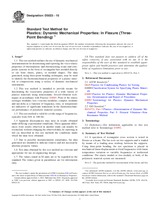Potrebujeme váš súhlas na využitie jednotlivých dát, aby sa vám okrem iného mohli ukazovať informácie týkajúce sa vašich záujmov. Súhlas udelíte kliknutím na tlačidlo „OK“.
ASTM D5023-15
Standard Test Method for Plastics: Dynamic Mechanical Properties: In Flexure (Three-Point Bending)
Automaticky preložený názov:
Štandardná testovacia metóda pre Plasty : dynamických mechanických vlastností : V ohybe ( trojbodový ohýbanie )
NORMA vydaná dňa 1.7.2015
Informácie o norme:
Označenie normy: ASTM D5023-15
Poznámka: NEPLATNÁ
Dátum vydania normy: 1.7.2015
Kód tovaru: NS-611341
Počet strán: 4
Približná hmotnosť: 12 g (0.03 libier)
Krajina: Americká technická norma
Kategória: Technické normy ASTM
Kategórie - podobné normy:
Anotácia textu normy ASTM D5023-15 :
Keywords:
dynamic mechanical rheological properties, elastic, flexural viscoelastic behavior, linear displacement, loss, storage modulus, tan delta,, ICS Number Code 83.080.01 (Plastics in general)
Doplňujúce informácie
| Significance and Use | ||||||||||
|
5.1 This test method provides a simple means of characterizing the thermomechanical behavior of plastic compositions using very small amounts of material. The data obtained may be used for quality control, research and development as well as the establishment of optimum processing conditions. 5.2 Dynamic mechanical testing provides a sensitive means for determining thermomechanical characteristics by measuring the elastic and loss moduli as a function of frequency, temperature, or time. Plots of moduli and tan delta of a material versus these variables can be used to provide a graphical representation indicative of functional properties, effectiveness of cure (thermosetting resin system), and damping behavior under specified conditions. 5.3 This test method can be used to assess: 5.3.1 Modulus as a function of temperature, 5.3.2 Modulus as a function of frequency, 5.3.3 The effects of processing treatment, 5.3.4 Relative resin behavioral properties, including cure and damping. 5.3.5 The effects of substrate types and orientation (fabrication) on modulus, 5.3.6 The effects of formulation additives which might affect processability or performance, 5.3.7 The effects of annealing on modulus and glass transition temperature, 5.3.8 The effect of aspect ratio on the modulus of fiber reinforcements, and 5.3.9 The effect of fillers, additives on modulus and glass transition temperature. 5.4 Before proceeding with this test method, refer to the specification of the material being tested. Any test specimen preparation, conditioning, dimensions, or testing parameters, or combination thereof, covered in the relevant ASTM materials specification shall take precedence over those mentioned in this test method. If there are no relevant ASTM material specifications, then the default conditions apply. |
||||||||||
| 1. Scope | ||||||||||
|
1.1 This test method outlines the use of dynamic mechanical instrumentation for determining and reporting the visco-elastic properties of thermoplastic and thermosetting resins and composite systems in the form of rectangular bars molded directly or cut from sheets, plates, or molded shapes. The data generated, using three-point bending techniques, may be used to identify the thermomechanical properties of a plastic material or compositions using a variety of dynamic mechanical instruments. 1.2 This test method is intended to provide means for determining the viscoelastic properties of a wide variety of plastics materials using nonresonant, forced-vibration techniques in accordance with Practice D4065. Plots of the elastic (storage) modulus; loss (viscous) modulus; complex modulus and tan delta as a function of frequency, time, or temperature are indicative of significant transitions in the thermomechanical performance of polymeric material systems. 1.3 This test method is valid for a wide range of frequencies, typically from 0.01 to 100 Hz. 1.4 Apparent discrepancies may arise in results obtained under differing experimental conditions. These apparent differences from results observed in another study can usually be reconciled, without changing the observed data, by reporting in full (as described in this test method) the conditions under which the data were obtained. 1.5 Due to possible instrumentation compliance, the data generated are intended to indicate relative and not necessarily absolute property values. 1.6 Test data obtained by this test method are relevant and appropriate for use in engineering design. 1.7 The values stated in SI units are to be regarded as the standard. The values given in parentheses are for information only. 1.8 This standard does not purport to address all of the safety concerns, if any, associated with its use. It is the responsibility of the user of this standard to establish appropriate safety and health practices and determine the applicability of regulatory limitations prior to use. Note 1: This test method is equivalent to ISO 6721, Part
5.
|
||||||||||
| 2. Referenced Documents | ||||||||||
|




 Cookies
Cookies
